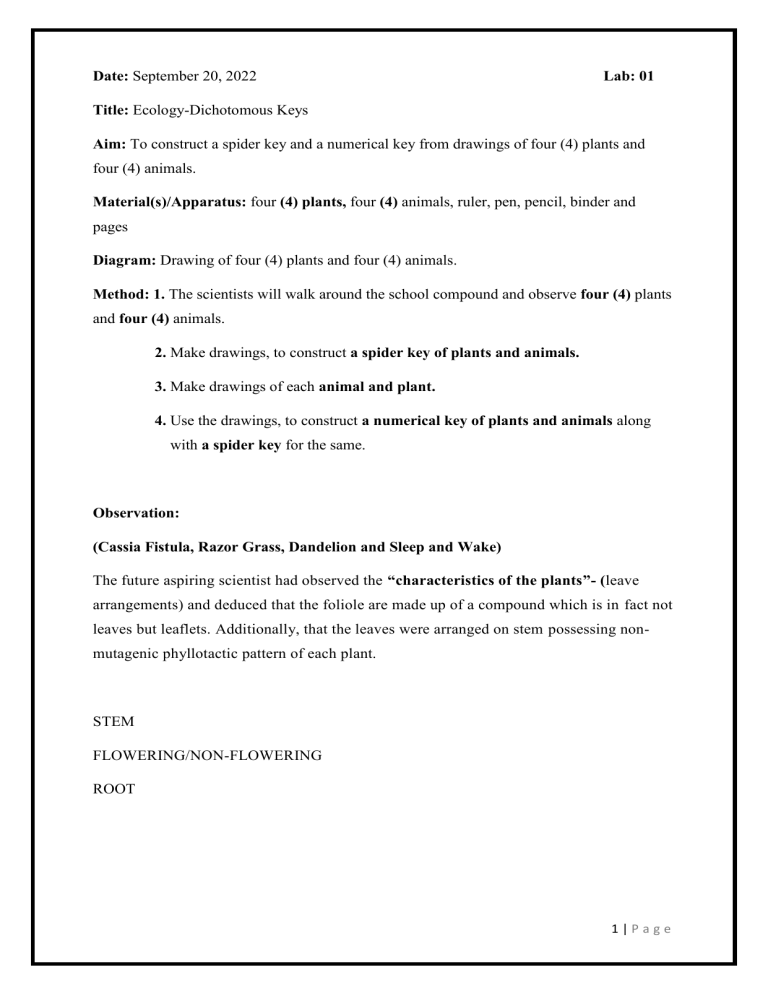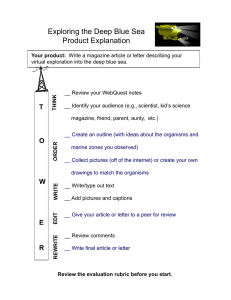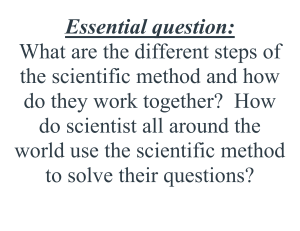
Date: September 20, 2022 Lab: 01 Title: Ecology-Dichotomous Keys Aim: To construct a spider key and a numerical key from drawings of four (4) plants and four (4) animals. Material(s)/Apparatus: four (4) plants, four (4) animals, ruler, pen, pencil, binder and pages Diagram: Drawing of four (4) plants and four (4) animals. Method: 1. The scientists will walk around the school compound and observe four (4) plants and four (4) animals. 2. Make drawings, to construct a spider key of plants and animals. 3. Make drawings of each animal and plant. 4. Use the drawings, to construct a numerical key of plants and animals along with a spider key for the same. Observation: (Cassia Fistula, Razor Grass, Dandelion and Sleep and Wake) The future aspiring scientist had observed the “characteristics of the plants”- (leave arrangements) and deduced that the foliole are made up of a compound which is in fact not leaves but leaflets. Additionally, that the leaves were arranged on stem possessing nonmutagenic phyllotactic pattern of each plant. STEM FLOWERING/NON-FLOWERING ROOT 1|Page Arthropods (Butterfly, Dragonfly, Spider and Ant) This hypothesis suggests that the insect's wings developed from paranotal lobes. Futhermore, supporting this hypothesis is the tendency of most insects, when there startled while climbing on branches in which their theory of escape is by dropping to the ground or in other words fake a dramatic death. BODY PARTS-SEGMENTED/…… REACTION WHEN ENCOUNTERING HUMANS AND OTHER ANIMALS 2|Page 3|Page Discussion: A dichotomous key is a tool created by scientists to help scientists and laypeople identify objects and organisms. (Biology Dictionary, Biologydictionary.net, 20 Mar. 2017) A dichotomous key is usually used for: Identifying and categorizing organisms Helping students easily understand harder scientific concepts Organizing large amounts of information to make identification of an organism much easier Reflection: The future aspiring scientist was able to acquire a clear understanding of the “known organisms”- (plants and animals) which were collected and understudied with regards to their feathers, unique scientific names and linkages to other kinds of groups. Notwithstanding, the people who would be exposed to this document that maybe new to the study of ecology can acquire a fair understanding of organisms, their scientific names, parts and classification. Thus, the future aspiring scientist was able to garnered information of the species of plants and animals; and their “classifications”- (whether there are related to single or closely related-group organisms). 4|Page This hypotenuse had made the aspiring scientist really understand the declaration of both plants and animals and obtain knowledge on their physical features and their well-being Conclusion: The aim of this experiment was to construct a spider key and a numerical key from drawings of four (4) plants and four (4) animals for the purpose of observing the characteristics of each living organisms that were collected from the “natural environment”-(school). This task helped the future aspiring scientist to identify and category organisms; make connections between known organisms with that of unknown organisms which were evolved overtime. While, understanding scientific concepts of the understudied organisms. Numerical Key for plants 1. leaf dicotyledonous leaves …. go to 2 Has monocotyledon …. go to 4 2. Has flowers…. Cassia Fistula Does not have flowers …. go to 3 3. Has Razors…. Razor Grass Does not have razors…. cassia fistula, sleep and wake, Dandelion 4. Has a soft, light texture… Dandelion Does not have a soft light texture…go to 5 5. Has Tap Root…. Razor Grass, sleep and wake Does not have Tap Root…. Cassia Fistula Numerical Key for Animals 1. Wings…Butterfly, Dragonfly No Wings…go to 2 5|Page 2. Hard plates on their back…Spider No hard plates on their plants…go to 3 3. As Antennae…. Butterfly, Dragon Fly, Ant No Antennae… Spider 5. Walks on 4 Legs…Butterfly, Dragonfly Walks on 8 legs…Spider, Ants 6|Page





